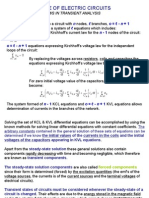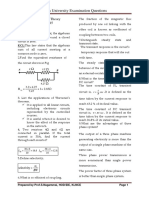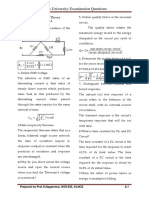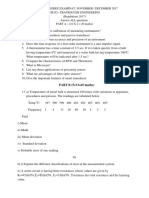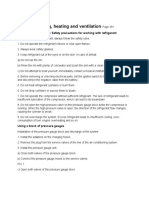Source Free RL Circuit
Uploaded by
Anonymous yO7rcec6vuSource Free RL Circuit
Uploaded by
Anonymous yO7rcec6vuTRANSIENT RESPONSE OF DC CIRCUITS
Introduction
When a circuit condition changes from one state to another state, either when the
applied voltage changes or when one of the circuit element changes, a transitional
period exists during which the branch currents & voltage drops change from their
earlier values to new values. After this transient period, the circuit reaches a steady
state value.
DIRECT CURRENT TRANSIENTS:
4.1. RL SERIES TRANSIENT CIRCUITS FOR DC INPUT
A constant voltage V is applied to the series RL circuit. When the switch is closed at
t 0 , as shown in Fig…
Applying KVL the differential equation is,
di(t )
Ri(t ) L V
dt
Taking the Laplace transform on both sides,
V
R SL I (s)
S
V
V L
I ( s)
S ( R SL) R
SS
L
Applying partial fraction expansion,
V
L A B
R S R
S (S ) S
L L
V R
A S B S
L L
Prepared by Prof.S.Nagammai, HOD/EIE/KLNCE Page 1
TRANSIENT RESPONSE OF DC CIRCUITS
Comparing the coefficients of like powers of ‘S’,
A B 0
AR V
L L
V V
Solving , A and B
R R
V 1 1
I (s)
RS R
S
L
V t
R
i (t ) 1 e L
R
The initial value of the current is, i(0) 0
V
The final value of current is i ( )
R
, i( ) 1 e
L V 0.632V
At t
1
R R R
At this time, the current is 63.2 % of its final value
This type of equation is known as an exponential rising function & and the plot of
current response is shown in Fig
The time constant (TC) is the time at which the power of exponent ‘e’ is unity.
L
Thus for the RL transient the time constant is, sec
R
The voltage drop across the resistor & inductor is,
Prepared by Prof.S.Nagammai, HOD/EIE/KLNCE Page 2
TRANSIENT RESPONSE OF DC CIRCUITS
V t t
R R
L
VR R i (t ) R 1 e V 1 e L
R
t
d V
R R
t
L
VL L 1 e Ve L
dt R
Source free RL circuit
Consider a source free RL circuit shown in Fig below. The inductor has an initial
current of I0 Amps.
The differential equation of the circuit is,
di (t )
R i (t ) L 0
dt
R I (s) L SI ( s) I 0 0
R SL I (s) I 0 L
R
S I ( s) I 0
L
I0
I (s)
R
S
L
Taking the inverse Laplace transform,
R
t
i(t ) I 0 e L
Prepared by Prof.S.Nagammai, HOD/EIE/KLNCE Page 3
TRANSIENT RESPONSE OF DC CIRCUITS
Problem 4.3: In the circuit shown in Fig… switch S1 is closed at t 0 & S 2 is opened
t 0.3sec . Find the expression for transient current for both the intervals.
Solution:
With switch S1 & S 2 closed at t 0 , the 50 resistor acts as a short circuit.
The differential equation is,
di(t )
20 i(t ) 2 100
dt
100
20 2S I (S )
S
50 5 10
I (S )
S S 5 S S 10
i(t ) 5 1 e10 t Amps
i(0.3) 5 1 e100.3 4.75 Amps
When switch S 2 is opened the differential equation is,
di(t )
70 i(t ) 2 100
dt
100
70 I ( S ) 2 S I ( S ) 4.75
S
100
70 2S I (S ) 9.5
S
50 4.75S
I (S )
S ( S 35)
Applying partial fraction expansion,
50 4.75S A B
S ( S 35) S S 35
50 4.75S A S 35 BS
Solving for constants A and B
Prepared by Prof.S.Nagammai, HOD/EIE/KLNCE Page 4
TRANSIENT RESPONSE OF DC CIRCUITS
A 1.43 and B 3.32
1.43 3.32
I (S )
S S 35
35t 0.2
i(t ) 1.43 3.32 e Amps for t 0.2sec
Problem 4.4: In the circuit shown in Fig…., the switch is closed for a long time. At t 0
the switch is opened. Calculate i (t ) for t 0 .
Solution:
Since the switch is closed for a long time, there exist steady state conditions. Under this
condition inductor acts a short circuit and 16 acts as dead element.
12 4
Now, RT 2 5
16
40 IT 12 8 12
IT 8 Amps i0 6 Amps
5 16 16
When the switch is opened, the circuit condition is shown in Fig 2
di (t )
8i(t ) 2 0
dt
8 I (S ) 2 S I (S ) i0 0
8 2S I (S ) 12
12 6
I (s)
8 2S S 4
i(t ) 6 e4t Amps for t 0 sec
Prepared by Prof.S.Nagammai, HOD/EIE/KLNCE Page 5
You might also like
- Dally, James W, Riley, William F. McConnell, Kenneth G - Instrumentation For Engineering Measurements-New York - Wiley (1984)No ratings yetDally, James W, Riley, William F. McConnell, Kenneth G - Instrumentation For Engineering Measurements-New York - Wiley (1984)600 pages
- Transient Response of DC Circuits: V It e RNo ratings yetTransient Response of DC Circuits: V It e R10 pages
- EE234 - Lec 4 - Applications of Laplace and Inverse Laplace Transforms-1No ratings yetEE234 - Lec 4 - Applications of Laplace and Inverse Laplace Transforms-113 pages
- Ele 201 - Introduction To Transient AnalysisNo ratings yetEle 201 - Introduction To Transient Analysis15 pages
- ELECTRICAL CIRCUIT ANALYSIS-DIGITAL NOTES (1) - CompressedNo ratings yetELECTRICAL CIRCUIT ANALYSIS-DIGITAL NOTES (1) - Compressed7 pages
- UNIT-1: Lecture Notes Unit 1: Transient AnalysisNo ratings yetUNIT-1: Lecture Notes Unit 1: Transient Analysis36 pages
- Transient Response For DC Circuits: Unit-IvNo ratings yetTransient Response For DC Circuits: Unit-Iv26 pages
- LecC_EE11003_DC_TRansients_10-12.02.25_DDNNo ratings yetLecC_EE11003_DC_TRansients_10-12.02.25_DDN40 pages
- Electricalcircuitsanalysis Digital NotesNo ratings yetElectricalcircuitsanalysis Digital Notes111 pages
- Chapter 4 - Transient Response of CircuitsNo ratings yetChapter 4 - Transient Response of Circuits10 pages
- Melbourne School of Engineering ELEN30009 Electrical Network Analysis & Design Semester 1, 2017No ratings yetMelbourne School of Engineering ELEN30009 Electrical Network Analysis & Design Semester 1, 201734 pages
- Transient State of Electric Circuits: Using Kirchhoff'S Laws in Transient AnalysisNo ratings yetTransient State of Electric Circuits: Using Kirchhoff'S Laws in Transient Analysis23 pages
- Network Analysis and Transmission LinesNo ratings yetNetwork Analysis and Transmission Lines105 pages
- Unit 2 Transient Response Laplace TransformNo ratings yetUnit 2 Transient Response Laplace Transform10 pages
- Unit 2 Transient Response With Diff EquationNo ratings yetUnit 2 Transient Response With Diff Equation24 pages
- Transient Circuit Analysis: 3.1. First Order Transient CircuitsNo ratings yetTransient Circuit Analysis: 3.1. First Order Transient Circuits14 pages
- Question Bank of Network Analysis and Synthesis UNIT-1 and UNIT-2100% (1)Question Bank of Network Analysis and Synthesis UNIT-1 and UNIT-29 pages
- Feynman Lectures Simplified 2C: Electromagnetism: in Relativity & in Dense MatterFrom EverandFeynman Lectures Simplified 2C: Electromagnetism: in Relativity & in Dense MatterNo ratings yet
- Fundamentals of Electronics 1: Electronic Components and Elementary FunctionsFrom EverandFundamentals of Electronics 1: Electronic Components and Elementary FunctionsNo ratings yet
- Anna University Examination Questions: EE6201-Circuit Theory NOV - 2014No ratings yetAnna University Examination Questions: EE6201-Circuit Theory NOV - 20148 pages
- Anna University Examination Questions: EE6201-Circuit Theory May - 2015No ratings yetAnna University Examination Questions: EE6201-Circuit Theory May - 20157 pages
- Anna University Examination Questions: EE6201-Circuit Theory NOV - 2015No ratings yetAnna University Examination Questions: EE6201-Circuit Theory NOV - 20159 pages
- Anna University Examination Questions: EE6201-Circuit Theory May - 2014No ratings yetAnna University Examination Questions: EE6201-Circuit Theory May - 20148 pages
- Ic6501 Control Systems: UNIT-1 (2 Mark Q/A)No ratings yetIc6501 Control Systems: UNIT-1 (2 Mark Q/A)6 pages
- Name: Digital Logic Circuits (Common To ICE) Part A (20X2 40 Marks) Answer All QuestionsNo ratings yetName: Digital Logic Circuits (Common To ICE) Part A (20X2 40 Marks) Answer All Questions2 pages
- Ei6801 - Computer Control of Process Part-A Answer All Questions (5x2 10)No ratings yetEi6801 - Computer Control of Process Part-A Answer All Questions (5x2 10)7 pages
- K L N College of Engineering Pottapalaym: 1 Gshs S 100No ratings yetK L N College of Engineering Pottapalaym: 1 Gshs S 1002 pages
- HSSRPTR - +1 Physics Focus Area Notes-AyyappanNo ratings yetHSSRPTR - +1 Physics Focus Area Notes-Ayyappan46 pages
- TANCET - Basic Engineering and Science 2012No ratings yetTANCET - Basic Engineering and Science 201215 pages
- Air Conditioning, Heating and Ventilation: Air Conditioning System Safety Precautions For Working With RefrigerantNo ratings yetAir Conditioning, Heating and Ventilation: Air Conditioning System Safety Precautions For Working With Refrigerant26 pages
- Pages From 112006967-PRV-Sizing-for-Exchanger-Tube-Rupture-4No ratings yetPages From 112006967-PRV-Sizing-for-Exchanger-Tube-Rupture-41 page
- Motion Sensor and Temperature Control System Using Atmega8 MicrocontrollerNo ratings yetMotion Sensor and Temperature Control System Using Atmega8 Microcontroller45 pages
- J C E E: Ournal Lub For Lectrical NgineeringNo ratings yetJ C E E: Ournal Lub For Lectrical Ngineering5 pages
- CBSE Class-12 Physics Quick Revision Notes Chapter-06: Electromagnetic Induction Magnetic FluxNo ratings yetCBSE Class-12 Physics Quick Revision Notes Chapter-06: Electromagnetic Induction Magnetic Flux5 pages
- Grade 7 and 8 (Prepare and Interpret Technical Drawings)No ratings yetGrade 7 and 8 (Prepare and Interpret Technical Drawings)21 pages
- Development of A Software Package For CaNo ratings yetDevelopment of A Software Package For Ca9 pages
- EN FANOXPC DATA CT LowVoltageOpenCTIndoor CT80II-ABR GC17 R03No ratings yetEN FANOXPC DATA CT LowVoltageOpenCTIndoor CT80II-ABR GC17 R031 page
- Dally, James W, Riley, William F. McConnell, Kenneth G - Instrumentation For Engineering Measurements-New York - Wiley (1984)Dally, James W, Riley, William F. McConnell, Kenneth G - Instrumentation For Engineering Measurements-New York - Wiley (1984)
- EE234 - Lec 4 - Applications of Laplace and Inverse Laplace Transforms-1EE234 - Lec 4 - Applications of Laplace and Inverse Laplace Transforms-1
- ELECTRICAL CIRCUIT ANALYSIS-DIGITAL NOTES (1) - CompressedELECTRICAL CIRCUIT ANALYSIS-DIGITAL NOTES (1) - Compressed
- Melbourne School of Engineering ELEN30009 Electrical Network Analysis & Design Semester 1, 2017Melbourne School of Engineering ELEN30009 Electrical Network Analysis & Design Semester 1, 2017
- Transient State of Electric Circuits: Using Kirchhoff'S Laws in Transient AnalysisTransient State of Electric Circuits: Using Kirchhoff'S Laws in Transient Analysis
- Transient Circuit Analysis: 3.1. First Order Transient CircuitsTransient Circuit Analysis: 3.1. First Order Transient Circuits
- Question Bank of Network Analysis and Synthesis UNIT-1 and UNIT-2Question Bank of Network Analysis and Synthesis UNIT-1 and UNIT-2
- Feynman Lectures Simplified 2C: Electromagnetism: in Relativity & in Dense MatterFrom EverandFeynman Lectures Simplified 2C: Electromagnetism: in Relativity & in Dense Matter
- Fundamentals of Electronics 1: Electronic Components and Elementary FunctionsFrom EverandFundamentals of Electronics 1: Electronic Components and Elementary Functions
- Anna University Examination Questions: EE6201-Circuit Theory NOV - 2014Anna University Examination Questions: EE6201-Circuit Theory NOV - 2014
- Anna University Examination Questions: EE6201-Circuit Theory May - 2015Anna University Examination Questions: EE6201-Circuit Theory May - 2015
- Anna University Examination Questions: EE6201-Circuit Theory NOV - 2015Anna University Examination Questions: EE6201-Circuit Theory NOV - 2015
- Anna University Examination Questions: EE6201-Circuit Theory May - 2014Anna University Examination Questions: EE6201-Circuit Theory May - 2014
- Name: Digital Logic Circuits (Common To ICE) Part A (20X2 40 Marks) Answer All QuestionsName: Digital Logic Circuits (Common To ICE) Part A (20X2 40 Marks) Answer All Questions
- Ei6801 - Computer Control of Process Part-A Answer All Questions (5x2 10)Ei6801 - Computer Control of Process Part-A Answer All Questions (5x2 10)
- K L N College of Engineering Pottapalaym: 1 Gshs S 100K L N College of Engineering Pottapalaym: 1 Gshs S 100
- Air Conditioning, Heating and Ventilation: Air Conditioning System Safety Precautions For Working With RefrigerantAir Conditioning, Heating and Ventilation: Air Conditioning System Safety Precautions For Working With Refrigerant
- Pages From 112006967-PRV-Sizing-for-Exchanger-Tube-Rupture-4Pages From 112006967-PRV-Sizing-for-Exchanger-Tube-Rupture-4
- Motion Sensor and Temperature Control System Using Atmega8 MicrocontrollerMotion Sensor and Temperature Control System Using Atmega8 Microcontroller
- CBSE Class-12 Physics Quick Revision Notes Chapter-06: Electromagnetic Induction Magnetic FluxCBSE Class-12 Physics Quick Revision Notes Chapter-06: Electromagnetic Induction Magnetic Flux
- Grade 7 and 8 (Prepare and Interpret Technical Drawings)Grade 7 and 8 (Prepare and Interpret Technical Drawings)
- EN FANOXPC DATA CT LowVoltageOpenCTIndoor CT80II-ABR GC17 R03EN FANOXPC DATA CT LowVoltageOpenCTIndoor CT80II-ABR GC17 R03






































